- Author: Steve Orloff

In order to get the “most bang for your buck”, treat seedling alfalfa fields during the optimum window. The old adage small weeds are easier to kill is true, especially for difficult-to-control weeds. In addition, by controlling weeds when they are small, there is less time for them to compete with the alfalfa and impact alfalfa vigor and stand density. Research I conducted years ago showed numerous seedling alfalfa herbicides were nearly twice as effective when applied at the 3 trifoliate leaf stage of the alfalfa than when the application was delayed a few weeks and applied at the 6 to 9 trifoliate leaf stage. Therefore, for conventional alfalfa it is usually best to make applications at the 2 to 3 trifoliate leaf stage for herbicides such as Raptor (imazamox) or Pursuit (imazethapyr). Late-emerging weeds can be a concern with some herbicides but this is usually not a problem with Raptor or Pursuit because they have soil residual activity as well as contact activity.
A more difficult question can be when to apply contact herbicides that have no soil residual activity. Factors to consider include the alfalfa canopy, weed size and whether the herbicide is used alone or as part of a tank-mix combination. Selective grass herbicides are usually applied as a tank-mix with Raptor or Pursuit to control both grasses and broadleaf weeds in a single application so the Raptor or Pursuit timing ordinarily dictates when the treatment is made. When a grass herbicide is applied alone, pay close attention to the size of the grasses and the amount of bare soil. Treat when most of the soil is covered by the alfalfa canopy but before the grasses get too large (less than 6 – 8 inches tall is usually best). Another important point with grass herbicides is to apply them while the grasses are actively growing and not moisture stressed.
With the advent of Roundup Ready® alfalfa, many growers are questioning when is the optimum time to apply Roundup since the alfalfa is tolerant at all growth stages and glyphosate is capable of killing relatively large weeds. My personal observation and research results have shown that the best time is a little later than for Raptor or Pursuit. Since glyphosate does not have soil residual activity, applications made at the 4-6 trifoliate leaf stage of the alfalfa have been effective. With this timing there is usually enough alfalfa cover that late-emerging weeds are insignificant and the weeds have not competed excessively with the alfalfa. However, apply earlier when more Roundup-tolerant weeds are present (such as cheeseweed, filaree, black mustard, knotweed, clover, etc.) or when weed competition is severe.



We're primarily focused on managing unwanted plants (ie weeds) in agricultural cropping systems in California. Here's a link to a little more information about the main weed in the blog post above.
http://ipm.ucanr.edu/PMG/WEEDS/mustards.html
I think your questions about beneficial medicinal uses of plants (weedy or otherwise) could better be addressed by medicinal or herbal-remedy based resources.
Good luck.
Brad